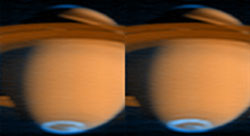New Cassini images show ’Northern Lights’ of Saturn

New ultraviolet images from Cassini spacecraft show auroral emissions at Saturn’s poles
New images of Saturn obtained by a University of Colorado at Boulder-led team on June 21 using an instrument on the Cassini spacecraft show auroral emissions at its poles similar to Earth’s Northern Lights.
Taken with the Ultraviolet Imaging Spectrograph aboard the Cassini orbiter, the two UV images, invisible to the human eye, are the first from the Cassini-Huygens mission to capture the entire “oval” of the auroral emissions at Saturn’s south pole. They also show similar emissions at Saturn’s north pole, according to CU-Boulder Professor Larry Esposito, principal investigator of the UVIS instrument built at CU-Boulder’s Laboratory for Atmospheric and Space Physics, and Professor Wayne Pryor of Central Arizona College, a UVIS team member and former CU graduate student.
In the false-color images, blue represents aurora emissions from hydrogen gas excited by electron bombardment, while red-orange represents reflected sunlight. The images show that the aurora lights at the polar regions respond rapidly to changes in the solar wind, said the researchers. Previous images have been taken closer to the equator, making it difficult to see the polar regions.
Major changes in the emissions inside the Saturn south-pole aurora are evident by comparing the two images, which were taken about one hour apart, they said. The brightest spot in the left aurora fades, and a bright spot appears in the middle of the aurora in the second image.
Made by slowly scanning the UVIS instrument across the planet, the images also contain more than 2,000 wavelengths of spectral information within each picture element. Researchers will use the wavelength information to study Saturn’s auroras, gases, and hazes and their changing distributions.
The UVIS observation team includes researchers from CU-Boulder, NASA’s Jet Propulsion Laboratory, Central Arizona College and the University of Southern California.
The Cassini-Huygens mission is a cooperative project of NASA, the European Space Agency and the Italian Space Agency. The Jet Propulsion Laboratory, a division of the California Institute of Technology in Pasadena, manages the Cassini- Huygens mission for NASA’s Space Science Mission Directorate in Washington, D.C.
Media Contact
All latest news from the category: Physics and Astronomy
This area deals with the fundamental laws and building blocks of nature and how they interact, the properties and the behavior of matter, and research into space and time and their structures.
innovations-report provides in-depth reports and articles on subjects such as astrophysics, laser technologies, nuclear, quantum, particle and solid-state physics, nanotechnologies, planetary research and findings (Mars, Venus) and developments related to the Hubble Telescope.
Newest articles

Sea slugs inspire highly stretchable biomedical sensor
USC Viterbi School of Engineering researcher Hangbo Zhao presents findings on highly stretchable and customizable microneedles for application in fields including neuroscience, tissue engineering, and wearable bioelectronics. The revolution in…

Twisting and binding matter waves with photons in a cavity
Precisely measuring the energy states of individual atoms has been a historical challenge for physicists due to atomic recoil. When an atom interacts with a photon, the atom “recoils” in…

Nanotubes, nanoparticles, and antibodies detect tiny amounts of fentanyl
New sensor is six orders of magnitude more sensitive than the next best thing. A research team at Pitt led by Alexander Star, a chemistry professor in the Kenneth P. Dietrich…





















